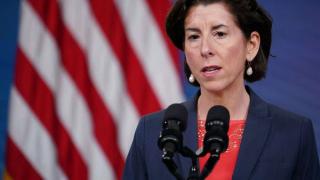This week top trade officials representing the 14 nations participating in the US-led Indo-Pacific Economic Framework for Prosperity will meet for their first face-to-face negotiation in Los Angeles.
Delegations from diverse Indo-Pacific economies including Australia, Japan, India, South Korea, Indonesia, and Singapore will look to US Secretary of Commerce Gina Raimondo and US Trade Representative Katherine Tai to determine just how serious the Biden administration is about returning to an economic leadership role in this region after the Trump administration’s unilateral withdrawal from the Trans-Pacific Partnership in 2017.
The economic and geopolitical stakes are huge. In the 2021 Lowy Institute Asia Power Index, the institute concluded American diplomatic influence is on the rise again with President Joe Biden, but American economic influence has deteriorated even more than it did under president Donald Trump. The authors of the White House’s 2022 Indo-Pacific Strategy know that and developed IPEF as the solution. But will the ministers deliver in LA?
Delegations from diverse Indo-Pacific economies including Australia, Japan, India, South Korea, Indonesia, and Singapore will look to US Secretary of Commerce Gina Raimondo and US Trade Representative Katherine Tai to determine just how serious the Biden administration is about returning to an economic leadership role in this region.
To shed more light on the debate in the US, the US Studies Centre invited an exchange on IPEF between two trade policy veterans in Washington, former assistant US trade representative Wendy Cutler and former international economic adviser and “sherpa” to President George W. Bush, Daniel Price. Price argues thus far that IPEF represents a “glass half empty,” noting: “When President Biden took office, his team pledged to pursue a foreign policy ‘for the middle class’ and a ‘worker-centric’ trade policy.
“Seventeen months later, they have yet to translate these slogans into a concrete, international agenda. US allies and partners increasingly fear these slogans provide not a ‘prism’ for US policy but a ‘prison’ that is paralysing US engagement.” The lack of market access provisions that characterised previous US negotiations, like the Australia-US free-trade agreement signed in 2005 and the TPP, is a particular impediment to liberalisation, in his view.
Cutler acknowledges its limits but sees IPEF thus far as “a glass half full”. She sees the negotiations as “a substantive, forward-looking initiative that focuses on some of the most pressing issues facing regional governments and their citizens, including unprecedented supply chain disruptions, severe climate change impacts, and a growing digital divide”. She acknowledges the importance of trade but sees value in going beyond traditional agreements to address broader issues confronting regional economies.
In my own consultations in the US with former trade officials I heard a common refrain: IPEF may be half empty or half full, but it is the only glass we have right now. Even those most committed to America’s return to the TPP believe the politics of that agreement became too complex. While most Americans when last polled in 2016 favoured the TPP and overall American public support for trade is higher than ever, conversely, the politics of trade became more difficult. One factor is the shifting positions of the Republican and Democratic parties.
For decades, Republicans were the free-trade party from the chamber of commerce to farmers looking for export markets. However, in the era of Trump, the pro-trade establishment Republicans are losing rank-and-file Republicans to protectionism and fear of globalisation. Meanwhile, the Democratic Party was traditionally the party of labour unions and more sceptical of trade. Now the grassroots Democrat members tend to be younger, more cosmopolitan and are favourable towards international trade, while the party establishment is dominated by sceptical trade unions. When Donald Trump stunned Hillary Clinton in 2016 by securing blue-collar labour votes in blue-collar swing states, politicians of both parties suddenly lost the courage of their convictions.
The Debate Papers: Is the Indo-Pacific Economic Framework glass half full or glass half empty?

So what will it take to turn IPEF into a framework that really shapes the regional economic agenda when China has ambitions to set trade rules on terms that would disadvantage American, Australian and other firms? In LA, the ministers are expected to announce which countries are joining the IPEF pillars focused on issues from digital trade to decarbonisation.
It is a coup that India and Indonesia are in the talks and adds real heft and diversity. But India and Indonesia also have terrible track records on reaching substantive trade agreements – most notably when India dropped out of the Regional Comprehensive Economic Partnership at the last minute rather than agree to meet the minimal standards for liberalisation required.
To keep everybody on board, IPEF has to stick to non-binding “trade facilitation” measures – or the kind of harmonisation of regulatory and access procedures that has been the work of APEC summits. That will help with rule-making in a very broad sense, but it will only deepen economic integration at the margins. IPEF may be a good start but, ultimately, the US cannot expect to meaningfully shape the regional economic order if it is unwilling to provide nations in the region an incentive – most notably, market access to the US – in return.
For now, a more ambitious approach is to decouple the IPEF pillar on trade to establish a binding digital trade agreement. This is significant given serious concerns about data reciprocity with China and the need to set rules for digital trade. But since it would not involve reduction of tariffs per se, it would be easier than the TPP. Given that Australia, Singapore and others have already negotiated such agreements with each other, achieving a broader regional agreement with core IPEF members could be quite achievable in the region.
Internationalists within the White House tried such an approach until progressive groups shut them down. But US trade politics remains fluid and powerful constituencies from national security experts to business leaders and younger Americans savvy about the digital economy could get behind such an agreement. Australia is well positioned as a catalyst to make IPEF real and would receive support from US allies such as Japan or Canada. The stakes for the US and the region merit such ambition right now.






